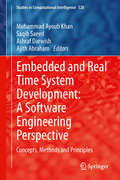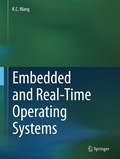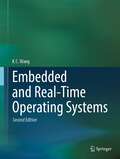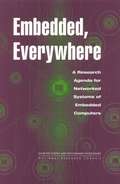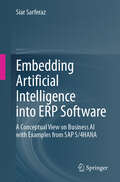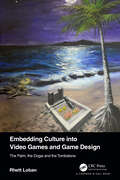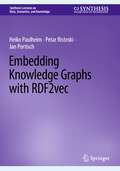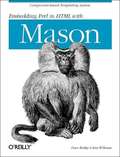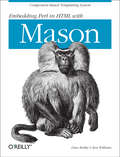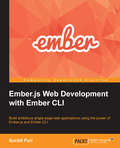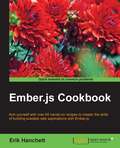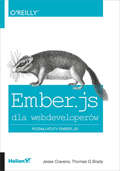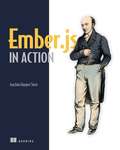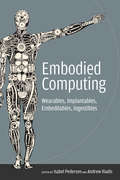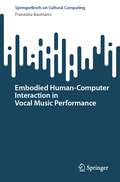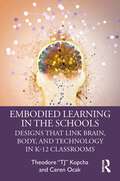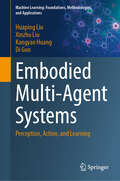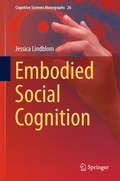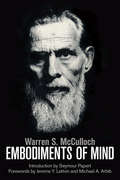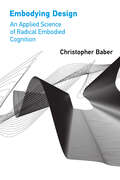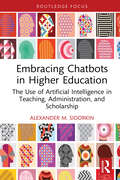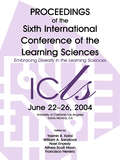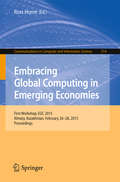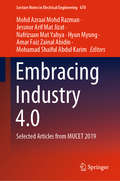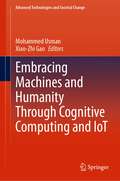- Table View
- List View
Embedded and Real Time System Development: A Software Engineering Perspective
by Ajith Abraham Saqib Saeed Ashraf Darwish Mohammad Ayoub KhanNowadays embedded and real-time systems contain complex software. The complexity of embedded systems is increasing, and the amount and variety of software in the embedded products are growing. This creates a big challenge for embedded and real-time software development processes and there is a need to develop separate metrics and benchmarks. "Embedded and Real Time System Development: A Software Engineering Perspective: Concepts, Methods and Principles" presents practical as well as conceptual knowledge of the latest tools, techniques and methodologies of embedded software engineering and real-time systems. Each chapter includes an in-depth investigation regarding the actual or potential role of software engineering tools in the context of the embedded system and real-time system. The book presents state-of-the art and future perspectives with industry experts, researchers, and academicians sharing ideas and experiences including surrounding frontier technologies, breakthroughs, innovative solutions and applications. The book is organized into four parts "Embedded Software Development Process", "Design Patterns and Development Methodology", "Modelling Framework" and "Performance Analysis, Power Management and Deployment" with altogether 12 chapters. The book is aiming at (i) undergraduate students and postgraduate students conducting research in the areas of embedded software engineering and real-time systems; (ii) researchers at universities and other institutions working in these fields; and (iii) practitioners in the R&D departments of embedded system. It can be used as an advanced reference for a course taught at the postgraduate level in embedded software engineering and real-time systems.
Embedded and Real-Time Operating Systems
by K. C. WangThis book covers the basic concepts and principles of operating systems, showing how to apply them to the design and implementation of complete operating systems for embedded and real-time systems. It includes all the foundational and background information on ARM architecture, ARM instructions and programming, toolchain for developing programs, virtual machines for software implementation and testing, program execution image, function call conventions, run-time stack usage and link C programs with assembly code. It describes the design and implementation of a complete OS for embedded systems in incremental steps, explaining the design principles and implementation techniques. For Symmetric Multiprocessing (SMP) embedded systems, the author examines the ARM MPcore processors, which include the SCU and GIC for interrupts routing and interprocessor communication and synchronization by Software Generated Interrupts (SGIs). Throughout the book, complete working sample systems demonstrate the design principles and implementation techniques. The content is suitable for advanced-level and graduate students working in software engineering, programming, and systems theory.
Embedded and Real-Time Operating Systems
by K. C. WangThis book covers the basic concepts and principles of operating systems, showing how to apply them to the design and implementation of complete operating systems for embedded and real-time systems. It includes all the foundational and background information on ARM architecture, ARM instructions and programming, toolchain for developing programs, virtual machines for software implementation and testing, program execution image, function call conventions, run-time stack usage and link C programs with assembly code.Embedded and Real-Time Operating Systems describes the design and implementation of a complete OS for embedded systems in incremental steps, explaining the design principles and implementation techniques. For Symmetric Multiprocessing (SMP) embedded systems, the author examines the ARM MPcore processors, which include the SCU and GIC for interrupts routing and interprocessor communication and synchronization by Software Generated Interrupts (SGIs).This Second Edition covers ARM64 architecture and programming. These include exception levels, vector tables and exceptions handling, GICv3 programming and interrupt processing. It covers virtual to physical address mappings in ARMv8, and shows a 64-bit OS with kernel space in EL1 and separate user spaces in EL0. It also covers ARM TrustZone technology and secure systems. These include hardware and software architectures for secure and normal worlds, interactions and switching between the two worlds. It shows a secure world comprising a secure monitor in EL3 to provide service functions, and a normal world comprising processes in non-secure EL1, which use SMC to access service functions in the secure world.Throughout the book, complete working sample systems demonstrate the design principles and implementation techniques. The content is suitable for advanced-level and graduate students working in software engineering, programming, and systems theory.
Embedded, Everywhere: A Research Agenda for Networked Systems of Embedded Computers
by Committee on Networked Systems of Embedded ComputersAdvances in the miniaturization and networking of microprocessors promise a _day when networked computers are embedded throughout the everyday world. However, our current understanding of what such systems would be like is insufficient to bring the promise to reality. Embedded, Everywhere explores the potential of networked systems of embedded computers and the research challenges arising from embedding computation and communications technology into a wide variety of applications—from precision agriculture to automotive telematics to defense systems. It describes how these emerging networks operate under unique constraints not present in more traditional distributed systems, such as the Internet. It articulates how these networks will have to be dynamically adaptive and self-configuring, and how new models for approaching programming and computation are necessary. Issues relating to trustworthiness, security, safety, reliability, usability, and privacy are examined in light of the ubiquitous nature of these systems. A comprehensive, systems-oriented research agenda is presented, along with recommendations to major federal funding agencies.
Embedding Artificial Intelligence into ERP Software: A Conceptual View on Business AI with Examples from SAP S/4HANA
by Siar SarferazThis book explains how to embed artificial intelligence in digitized business processes of ERP software by solving the two related substantial challenges: how can artificial intelligence be systematically integrated into ERP business processes for ease of consumption, and how can artificial intelligence be made enterprise-ready by covering ERP qualities like compliance, lifecycle management, extensibility, or scalability? As a general introduction, the first part of this book takes the reader through a historical journey towards intelligent ERP systems. In addition, reference processes and a reference architecture for ERP systems are proposed which build the foundation for the suggested subsequent solution concept, including a method for operationalizing intelligence for ERP business processes. Subsequently, in the second part detailed concepts of embedding artificial intelligence into ERP software are proposed. In this context the suggested solution architecture is depicted, and specific topics are resolved like data integration, model validation, explainability, data protection and privacy, model degradation and performance. In the last part an implementation framework is suggested which enables the previously introduced concepts and harmonizes the development and operations of artificial intelligent ERP applications. This part concludes with case studies considering artificial intelligence scenarios of SAP S/4HANA in the areas of logistics, finance and sales which apply the defined solution approach and shows its real-world feasibility. This book is written for professionals who want to implement (as developers) or exploit (as business analysts or consultants) or consider/plan the implementation/exploitation (as managers) of artificial intelligence in business information systems.
Embedding Culture into Video Games and Game Design: The Palm, the Dogai and the Tombstone
by Rhett LobanThis book will help game designers and those interested in games thoughtfully embed culture into video games and the game design process. This book raises the issue of how some cultures and communities are misrepresented in various video games. In response to this problem, designers can bring cultural considerations and practices into the centre focus of the game design process. The book advocates that designers put different measures in place to better prevent misrepresentations and engage with deeper understandings of culture to build culturally richer and more meaningful game worlds. The book uses the Torres Strait Virtual Reality project as a primary example, in addition to other game projects, to explore cultural representation in game design. Torres Strait culture is also explored and discussed more broadly throughout the book. No prior knowledge of culture studies is needed, and the book deals with higher level game design with little reference to the technical elements of game development. This unique and timely book will appeal to those interested in the implications of cultural depictions in video games and opportunities to generate deeper cultural representations through the game design process.
Embedding Knowledge Graphs with RDF2vec (Synthesis Lectures on Data, Semantics, and Knowledge)
by Heiko Paulheim Petar Ristoski Jan PortischThis book explains the ideas behind one of the most well-known methods for knowledge graph embedding of transformations to compute vector representations from a graph, known as RDF2vec. The authors describe its usage in practice, from reusing pre-trained knowledge graph embeddings to training tailored vectors for a knowledge graph at hand. They also demonstrate different extensions of RDF2vec and how they affect not only the downstream performance, but also the expressivity of the resulting vector representation, and analyze the resulting vector spaces and the semantic properties they encode.
Embedding Perl in HTML with Mason
by Dave Rolsky Ken WilliamsMason doesn't aim to be the one true Perl-based templating system for building web sites, but it's led many programmers to abandon their custom solutions when they've seen how much easier using Mason can be. It's a powerful, open source, Perl-based web site development and delivery engine, with features that make it an ideal backend for high load sites serving dynamic content. Mason uses a concept called components: a mix of HTML, Perl, and special Mason commands. These components can be entire web pages, or bits of HTML that can be embedded in top-level components. Shared and reusable, these components greatly simplify site maintenance: when you change a shared component, you instantly change all pages that refer to it. Although using Mason isn't difficult, creating a Mason-based site can be tricky. Embedding Perl in HTML with Mason , written by members of Mason's core development team, shows you how to take advantage of Mason's strengths while avoiding the obstacles that inexperienced users may encounter. Mason's unique features, when used properly, can streamline the design of a web site or application. This concise book covers these features from several angles, and includes a study of the authors' sample site where these features are used. Embedding Perl in HTML with Mason shows you how to create large, complex, dynamically driven web sites that look good and are a snap to maintain. You'll learn how to visualize multiple Mason-based solutions to any given problem and select among them. The book covers the latest line of Mason development 1.1x, which has many new features, including line number reporting based on source files, sub-requests, and easier use as a CGI. The only book to cover this important tool, Embedding Perl in HTML with Mason is essential reading for any Perl programmer who wants to simplify web site design. Learn how to use Mason, and you'll spend more time making things work, and less time reinventing the wheel.
Embedding Perl in HTML with Mason
by Dave Rolsky Ken WilliamsMason doesn't aim to be the one true Perl-based templating system for building web sites, but it's led many programmers to abandon their custom solutions when they've seen how much easier using Mason can be. It's a powerful, open source, Perl-based web site development and delivery engine, with features that make it an ideal backend for high load sites serving dynamic content. Mason uses a concept called components: a mix of HTML, Perl, and special Mason commands. These components can be entire web pages, or bits of HTML that can be embedded in top-level components. Shared and reusable, these components greatly simplify site maintenance: when you change a shared component, you instantly change all pages that refer to it. Although using Mason isn't difficult, creating a Mason-based site can be tricky. Embedding Perl in HTML with Mason, written by members of Mason's core development team, shows you how to take advantage of Mason's strengths while avoiding the obstacles that inexperienced users may encounter. Mason's unique features, when used properly, can streamline the design of a web site or application. This concise book covers these features from several angles, and includes a study of the authors' sample site where these features are used. Embedding Perl in HTML with Mason shows you how to create large, complex, dynamically driven web sites that look good and are a snap to maintain. You'll learn how to visualize multiple Mason-based solutions to any given problem and select among them. The book covers the latest line of Mason development 1.1x, which has many new features, including line number reporting based on source files, sub-requests, and easier use as a CGI. The only book to cover this important tool, Embedding Perl in HTML with Mason is essential reading for any Perl programmer who wants to simplify web site design. Learn how to use Mason, and you'll spend more time making things work, and less time reinventing the wheel.
Ember.js Web Development with Ember CLI
by Suchit PuriIf you are a JavaScript developer who is starting out to build ambitious Ember.js application, or a developer who has prior Ember.js experience and want to transition your application to the latest Ember.js version with Ember CLI, then this book is for you.
Ember.js cookbook
by Erik HanchettAnyone who wants to explore Ember.js and wishes to get hands on making sophisticated web apps with less coding will find this book handy. Prior experience in Coding and familiarity with JavaScript is recommended. If you've heard of Ember.js or are just curious on how a single-page application framework works, then this book is for you.
Ember.js dla webdeveloperów
by Jesse Cravens Thomas Q BradyPoznaj atuty Ember.js!Ember.js to biblioteka j?zyka JavaScript, dzi?ki której mo?esz sprawnie budowa? aplikacje na podstawie wzorca MVC (ang. Model View Controller). Ember.js znakomicie sprawdza si? przy tworzeniu jednostronicowych aplikacji internetowych (ang. Single Page Applications), a ponadto usprawnia automatyczne aktualizowanie szablonów czy dwustronne wi?zanie danych. Je?eli chcesz zg??bi? tajniki tej biblioteki, ta ksi??ka jest dla Ciebie.Dzi?ki niej poznasz potencja? Ember.js, jej atuty oraz techniki pracy. Lektura kolejnych rozdzia?ów pozwoli Ci pozna? zasady dzia?ania generatora aplikacji Ember i szablonów, a tak?e proces budowy modelu danych i kontrolerów. Na sam koniec dowiesz si?, jak zapisywa? dane po stronie klienta. Po zg??bieniu mo?liwo?ci Ember.js nauczysz si? przygotowywa? serwer, który b?dzie przetwarza? ??dania wysy?ane z Twojej aplikacji. W tym celu wykorzystasz Rails MVC. W trakcie lektury zbudujesz w?asn? aplikacj? o nazwie Rock’n’roll. Jeste? ciekaw, co potrafi? Si?gnij po t? ksi??k? i przekonaj si? sam! Przygotuj ?rodowisko pracy oraz wygeneruj podstawowy kod. Sprawd?, w jaki sposób „ergonomia” zapewniana przez Ember pozwala minimalizowa? ilo?? kodu. Przygotuj szablony dla prototypu ksi??ki dzi?ki Handlebars.js. Wykorzystaj rutery do zarz?dzania stanem aplikacji bez prze?adowywania zawarto?ci strony. Po??cz kontrolery i widoki ze zdarzeniami oraz synchronizuj dane dzi?ki powi?zaniom. Przygotuj infrastruktur? wspieraj?c? Ember za pomoc? REST-owego API lub Ruby on Rails. Wykorzystaj bibliotek? Data do zapisywania danych i komunikacji z infrastruktur? wspieraj?c?. Twórz uniwersalne modularne wid?ety rozszerzaj?ce mo?liwo?ci Twoich aplikacji.Pisz ambitne programy w JavaScript. Z Ember.js zaawansowane aplikacje internetowe s? w Twoim zasi?gu!
Ember.js in Action
by Joachim Haagen SkeieSummaryEmber.js in Action is a crisp tutorial that introduces the Ember.js framework and shows you how to build production-quality web applications. You'll begin with the basic architecture: client- and server-side MVC, integrating Ember.js with your favorite back end, handling data ... and more. You'll explore the amazing Handlebars templating engine that automatically updates your apps when the data behind them changes. Along the way, you'll develop a complete Ember.js application and learn how to deploy, administer, and update it efficiently.Purchase of the print book includes a free eBook in PDF, Kindle, and ePub formats from Manning Publications.About the TechnologyEmber.js is a JavaScript MVC framework that handles important tasks like managing code modules, maintaining state, and expediting reliable data flow. It provides the patterns, components, and scaffolding you need to build ambitious web applications.About the BookEmber.js in Action introduces the Ember.js framework and shows you how to build full-featured, desktop-quality web applications. You'll begin with the basic architecture: client- and server-side MVC and how to integrate Ember.js with your favorite back end. Then you'll explore the amazing Handlebars templating engine that automatically updates your apps when the data behind them changes. Along the way, you'll develop a complete Ember.js application and learn how to deploy, administer, and update it efficiently.Readers of this book need to know JavaScript. No prior experience with Ember.js is required.What's InsideWorking with Ember DataMastering Handlebars templatesAdvanced JavaScript techniquesCovers Ember.js 1.0About the AuthorJoachim Haagen Skeie is an experienced web application developer and the author of Montric, an open source monitoring tool built using Ember.js.Table of ContentsPART 1 EMBER.JS FUNDAMENTALSPowering your next ambitious web applicationThe Ember.js wayPutting everything together using Ember.js RouterAutomatically updating templates with Handlebars.jsPART 2 BUILDING AMBITIOUS WEB APPS FOR THE REAL WORLDBringing home the bacon—interfacing with the server side using Ember DataInterfacing with the server side without using Ember DataWriting custom componentsTesting your Ember.js applicationPART 3 ADVANCED EMBER.JS TOPICSAuthentication through a third-party system—Mozilla PersonaThe Ember.js run loop—Backburner.jsPackaging and deployment
Embodied Computing: Wearables, Implantables, Embeddables, Ingestibles (The\mit Press Ser.)
by Isabel Pedersen Andrew IliadisPractitioners and scholars explore ethical, social, and conceptual issues arising in relation to such devices as fitness monitors, neural implants, and a toe-controlled computer mouse.Body-centered computing now goes beyond the “wearable” to encompass implants, bionic technology, and ingestible sensors—technologies that point to hybrid bodies and blurred boundaries between human, computer, and artificial intelligence platforms. Such technologies promise to reconfigure the relationship between bodies and their environment, enabling new kinds of physiological interfacing, embodiment, and productivity. Using the term embodied computing to describe these devices, this book offers essays by practitioners and scholars from a variety of disciplines that explore the accompanying ethical, social, and conceptual issues. The contributors examine technologies that range from fitness monitors to neural implants to a toe-controlled mouse. They discuss topics that include the policy implications of ingestibles; the invasive potential of body area networks, which transmit data from bodily devices to the internet; cyborg experiments, linking a human brain directly to a computer; the evolution of the ankle monitor and other intrusive electronic monitoring devices; fashiontech, which offers users an aura of “cool” in exchange for their data; and the “final frontier” of technosupremacism: technologies that seek to read our minds. Taken together, the essays show the importance of considering embodied technologies in their social and political contexts rather than in isolated subjectivity or in purely quantitative terms.ContributorsRoba Abbas, Andrew Iliadis, Gary Genosko, Suneel Jethani, Deborah Lupton, Katina Michael, M. G. Michael, Marcel O'Gorman, Maggie Orth, Isabel Pedersen, Christine Perakslis, Kevin Warwick, Elizabeth Wissinger
Embodied Human–Computer Interaction in Vocal Music Performance (Springer Series on Cultural Computing)
by Franziska BaumannThis SpringerBrief provides a unique insight into the practice and research of the connections between voice, HCI and embodiment. Specifically, it explores how the voice can be embodied and mediated by means of gestural communication through sensor interfaces and aims to situate and contextualise various aspects that generate meaningful connections in such interactive interface performance. The author offers an approach for understanding creative practices between humans and computers in gestural live music performance, from the perspective of the embodied relationships created within such systems. Underlying practices, principles and sensor technologies that support creativity in embodied human-computer interaction in vocal music performance are examined and a dynamic framework and tools for anyone wishing to engage with this subject in depth are presented. The book is essential reading not only for musicians, composers, researchers, application developers, musicologists and educators but also for students and tertiary institutions as well as actors and dramaturgs in a music context.
Embodied Learning in the Schools: Designs That Link Brain, Body, and Technology in K-12 Classrooms
by Theodore “TJ” Kopcha Ceren OcakEmbodied Learning in the Schools explores the relevance of embodied perspectives to instructional designers and education scholars seeking to improve the design, development, and analysis of technology-enhanced learning environments in K-12 settings. Given recent technological advances in touch-based, geolocational, and body integrative devices, there is considerable opportunity to leverage embodied perspectives of cognition to enrich learning in schools today. Grounded in research and theory, this book provides a holistic understanding of embodied cognition’s powerful multidisciplinary applications. Using vivid examples from authentic classrooms, each chapter connects varied theoretical insights to their practical implications for linking brain, body, and technology in learning. Instructional designers, learning scientists, educational technologists, and other scholars and professionals will come away with a comprehensive grasp on the affordances, challenges, frameworks, and embodied designs that can be implemented in real-world contexts across subject areas.
Embodied Multi-Agent Systems: Perception, Action, and Learning (Machine Learning: Foundations, Methodologies, and Applications)
by Huaping Liu Di Guo Xinzhu Liu Kangyao HuangIn recent years, embodied multi-agent systems, including multi-robots, have emerged as essential solution for demanding tasks such as search and rescue, environmental monitoring, and space exploration. Effective collaboration among these agents is crucial but presents significant challenges due to differences in morphology and capabilities, especially in heterogenous systems. While existing books address collaboration control, perception, and learning, there is a gap in focusing on active perception and interactive learning for embodied multi-agent systems. This book aims to bridge this gap by establishing a unified framework for perception and learning in embodied multi-agent systems. It presents and discusses the perception-action-learning loop, offering systematic solutions for various types of agents—homogeneous, heterogeneous, and ad hoc. Beyond the popular reinforcement learning techniques, the book provides insights into using fundamental models to tackle complex collaboration problems. By interchangeably utilizing constrained optimization, reinforcement learning, and fundamental models, this book offers a comprehensive toolkit for solving different types of embodied multi-agent problems. Readers will gain an understanding of the advantages and disadvantages of each method for various tasks. This book will be particularly valuable to graduate students and professional researchers in robotics and machine learning. It provides a robust learning framework for addressing practical challenges in embodied multi-agent systems and demonstrates the promising potential of fundamental models for scenario generation, policy learning, and planning in complex collaboration problems.
Embodied Social Cognition
by Jessica LindblomThis book clarifies the role and relevance of the body in social interaction and cognition from an embodied cognitive science perspective. Theories of embodied cognition have during the last decades offered a radical shift in explanations of the human mind, from traditional computationalism, to emphasizing the way cognition is shaped by the body and its sensorimotor interaction with the surrounding social and material world. This book presents a theoretical framework for the relational nature of embodied social cognition, which is based on an interdisciplinary approach that ranges historically in time and across different disciplines. It includes work in cognitive science, artificial intelligence, phenomenology, ethology, developmental psychology, neuroscience, social psychology, linguistics, communication and gesture studies. The theoretical framework is illustrated by empirical work that provides some detailed observational fieldwork on embodied actions captured in three different episodes of spontaneous social interaction and cognition in situ. Furthermore, the theoretical contributions and implications of the study of embodied social cognition are discussed and summed up. Finally, the issue what it would take for an artificial system to be socially embodied is addressed and discussed, as well as the practical relevance for applications to artificial intelligence (AI) and socially interactive technology.
Embodiments of Mind (The\mit Press Ser.)
by Warren S. McCullochWritings by a thinker—a psychiatrist, a philosopher, a cybernetician, and a poet—whose ideas about mind and brain were far ahead of his time.Warren S. McCulloch was an original thinker, in many respects far ahead of his time. McCulloch, who was a psychiatrist, a philosopher, a teacher, a mathematician, and a poet, termed his work “experimental epistemology.” He said, “There is one answer, only one, toward which I've groped for thirty years: to find out how brains work.” Embodiments of Mind, first published more than fifty years ago, teems with intriguing concepts about the mind/brain that are highly relevant to recent developments in neuroscience and neural networks. It includes two classic papers coauthored with Walter Pitts, one of which applies Boolean algebra to neurons considered as gates, and the other of which shows the kind of nervous circuitry that could be used in perceiving universals. These first models are part of the basis of artificial intelligence.Chapters range from “What Is a Number, that a Man May Know It, and a Man, that He May Know a Number,” and “Why the Mind Is in the Head,” to “What the Frog's Eye Tells the Frog's Brain” (with Jerome Lettvin, Humberto Maturana, and Walter Pitts), “Machines that Think and Want,” and “A Logical Calculus of the Ideas Immanent in Nervous Activity” (with Walter Pitts). Embodiments of Mind concludes with a selection of McCulloch's poems and sonnets. This reissued edition offers a new foreword and a biographical essay by McCulloch's one-time research assistant, the neuroscientist and computer scientist Michael Arbib.
Embodying Design: An Applied Science of Radical Embodied Cognition
by Christopher BaberRethinking design through the lens of embodied cognition provides a novel way of understanding human interaction with technology. In this book, Christopher Baber uses embodied cognition as a lens through which to view both how designers engage in creative practices and how people use designed artifacts. This view of cognition as enactive, embedded, situated, or distributed, without recourse to internal representations, provides a theoretical grounding that makes possible a richer account of human interaction with technology. This understanding of everyday interactions with things in the world reveals opportunities for design to intervene. Moreover, Baber argues, design is an embodied activity in which the continual engagement between designers and their materials is at the heart of design practice. Baber proposes that design and creativity should be considered in dynamic, rather than discrete, terms and explores &“task ecologies&”—the concept of environment as it relates to embodied cognition. He uses a theory of affordance as an essential premise for design practice, arguing that affordances are neither form nor function but arise from the dynamics within the human-artifact-environment system. Baber explores agency and intent of smart devices and implications of tangible user interfaces and activity recognition for human-computer interaction. He proposes a systems view of human-artifact-environment interactions—to focus on any one component or pairing misses the subtleties of these interactions. The boundaries between components remain, but the borders that allow exchange of information and action are permeable, which gives rise to synergies and interactions.
Embracing Chatbots in Higher Education: The Use of Artificial Intelligence in Teaching, Administration, and Scholarship (Routledge Research in Digital Education and Educational Technology)
by Alexander M. SidorkinThis book explores the integration of AI-powered chatbots such as ChatGPT into higher education for instructional and communication purposes. The author emphasizes the responsibility of higher education institutions to equip students with advanced skills for writing with AI assistance, and prepare them for an increasingly AI-driven world.Offering numerous practical tips, the book demonstrates how universities can increase student success, and stem the rising cost of higher education by employing AI tools. The chapters discuss streamlining tasks such as grading, providing feedback, and handling administrative duties, to show how educators can be enabled to focus on more meaningful aspects of their work. The author also reflects on the philosophical and ethical considerations and potential pitfalls of relying on AI in higher education, including concerns about academic integrity and the importance of human input in the learning process. The author offers a responsible and informed approach to incorporating the new powerful tools into the academic landscape.This volume will be a key resource for higher education faculty and administrators seeking to navigate the complex intersection of AI and writing.
Embracing Diversity in the Learning Sciences: Proceedings of the Sixth International Conference of the Learning Sciences
by Yasmin B. Kafai Francisco Herrera William A. Sandoval Noel Enyedy Althea Scott NixonMore than a decade has passed since the First International Conference of the Learning Sciences (ICLS) was held at Northwestern University in 1991. The conference has now become an established place for researchers to gather. The 2004 meeting is the first under the official sponsorship of the International Society of the Learning Sciences (ISLS). The theme of this conference is "Embracing Diversity in the Learning Sciences." As a field, the learning sciences have always drawn from a diverse set of disciplines to study learning in an array of settings. Psychology, cognitive science, anthropology, and artificial intelligence have all contributed to the development of methodologies to study learning in schools, museums, and organizations. As the field grows, however, it increasingly recognizes the challenges to studying and changing learning environments across levels in complex social systems. This demands attention to new kinds of diversity in who, what, and how we study; and to the issues raised to develop coherent accounts of how learning occurs. Ranging from schools to families, and across all levels of formal schooling from pre-school through higher education, this ideology can be supported in a multitude of social contexts. The papers in these conference proceedings respond to the call.
Embracing Global Computing in Emerging Economies
by Ross HorneThis book constitutes the refereed proceedings of the First Workshop on Embracing Global Computing in Emerging Economies, EGC 2015, held in Almaty, Kazakhstan, in February 2015. The 13 revised full papers presented were carefully reviewed and selected from 28 submissions. The papers focus on the topic in two ways: one part is directly relevant to the problems of delivering cloud services in an emerging economy such as Kazakhstan, the other part represents ICT innovation by scientists of the region.
Embracing Industry 4.0: Selected Articles from MUCET 2019 (Lecture Notes in Electrical Engineering #678)
by Hyun Myung Nafrizuan Mat Yahya Mohd Azraai Mohd Razman Jessnor Arif Mat Jizat Amar Faiz Zainal Abidin Mohamad Shaiful Abdul KarimThis book highlights selected articles from the electrical engineering track, with a focus on the latest trends in electrical and electronic engineering toward embracing Industry 4.0, as part of the Malaysian Technical Universities Conference on Engineering and Technology—MUCET 2019. The event brings together researchers and professionals in the fields of engineering, research, and technology, and provides a platform for future collaborations and exchanges.
Embracing Machines and Humanity Through Cognitive Computing and IoT (Advanced Technologies and Societal Change)
by Xiao-Zhi Gao Mohammed UsmanThis book sheds light on systems that learn extensively, with purpose and naturally interact with humans. Improving operations and increasing competitive differentiation among manufacturing organizations by harnessing the power of cognitive abilities, IoT can help build and influence the flow of information—making the shop floor more cognitive through effective processing, analysis, and operational optimization. Now we are seeing the first-hand potential of cognitive computing—its ability to transform businesses, governments, and society. The real potential of the cognitive age can be realized by combining data analysis and statistical reasoning of machines with uniquely human qualities, such as self-directed goals, common sense, and moral values, improving operations and increasing competitive differentiation among manufacturing organizations. By harnessing the power of cognitive abilities, IoT can help build and influence the flow of information—making the shop floor more cognitive through effective processing, analysis, and operational optimization. Cognitive initiatives come in all shapes and sizes, from change to strategy and everything in between. What most successful projects have in common, no matter how ambitious, is they start with a clear view of what technology can do. Therefore, the first job of a cognitive scientists is to gain a firm understanding of cognitive abilities, as presented in this book.
